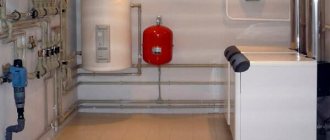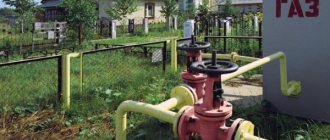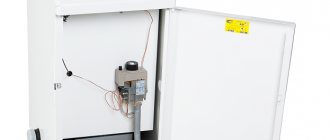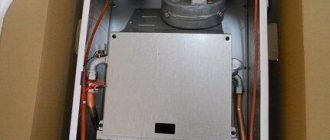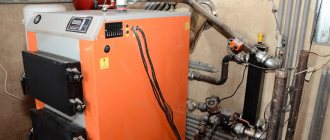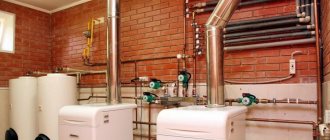Any gas equipment carries potential danger. Can a gas water heater explode? For some reason, many users believe that operating a boiler or water heater is much more dangerous than, for example, a gas stove. Is it so? Under normal conditions there will be no explosion, but improper installation or failure may increase the likelihood of this happening.
For what reasons does equipment explode, and how to avoid such a fate? Let's look at it in detail.
Why might an explosion happen?
Experts list the main reasons for such consequences:
- Self-connection . Please note that it is possible to install and install the speaker yourself. You can hang the device and connect a water pipeline to it. But you must entrust the connection to the gas main to a professional. Initially, you need to collect documents and installation permits. Then you contact the gas service, which will come to the call and connect the device. Only after this can the column be put into operation.
- Soviet gas water heater . Why is this dangerous? Outdated equipment does not have a protection system. This includes control sensors and thermostats that monitor the operation of each unit. In case of overheating or fuel leakage, the old device will not respond.
It has been proven that an explosion occurs when the gas concentration in the air reaches 5–15%.
- Unauthorized changes to the design of equipment . It is prohibited to change anything in the speaker structure yourself. If work is disrupted, not only a breakdown, but also an explosion is quite possible.
Can a modern gas boiler/heater explode?
Theoretically, for a vehicle to explode, the following reasons are necessary:
- The empty pipe is heated without coolant.
- The water in the radiator does not circulate, but stands and boils to critical temperatures.

Both are impossible, because even the cheapest Economy Class speakers have a security system installed. Empty pipes will not heat up because until you open the faucet to supply water, the burner will not start. And as soon as you close it, the heating will stop.
The heating temperature and liquid flow rate are controlled by special sensors. All models are equipped with these sensors:
- Thermal sensor. Monitors temperature rise. As soon as the water heats up to the set value, it sends a signal to the main module and it turns off the heating.
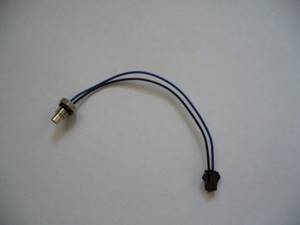
- Flow sensor. Fixes the pressure speed in pipes.
- Flexible diaphragm. Serves to open the gas valve. If the pressure in the line is sufficient, then the membrane bends and fuel enters the burner. As soon as the pressure decreases, the membrane returns to its original position and the gas supply stops.
- Ionization sensor. If the flame in the burner goes out, the sensor sends a signal to turn off the equipment.
- Exhaust product sensor. Reacts to the lack of draft in the chimney. Ideally, smoke should exit normally through the smoke shaft. If this does not happen, protection is triggered. Did you hear that it smells like burning? Then check the chimney. If there is a blockage, the shaft is cleaned.
Smell of gas from the boiler in the house? Close the shut-off valves and call the gas service to check.
Danger arises when the operation of equipment gets out of control. What experts recommend doing to avoid emergency situations:
- Buy heating equipment only in specialized stores. Get a guarantee so that in case of a breakdown you can contact a service center.
- Trust the connection to specialists.
- Carry out breakdown prevention and maintenance once a year. Clean components and parts from scale, soot and blockages.
- If problems are observed during ignition (the column bangs or slams), be sure to contact a specialist.
Any technique can be dangerous if used incorrectly. Monitor the operation of your devices, then you won’t have to deal with the consequences.
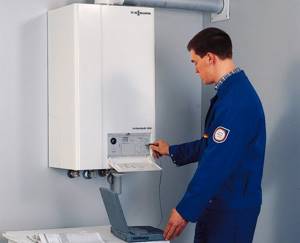
A gas stove and boiler or water heater are common household items that nevertheless require special treatment. After all, due to improper use, they can be dangerous. Gas service specialists give an example: in 2021, a 12-year-old girl died in Grodno. In the evening she took a bath, where a gas boiler was installed. A carbon monoxide leak occurred and the schoolgirl lost consciousness and subsequently choked to death. Denis Timoshko, Deputy Head of the Operation Service for In-House Gas-Using Equipment at the Grodnogaz Production Unit, spoke about how not to turn the boiler and stove into an enemy.
Everything's under control
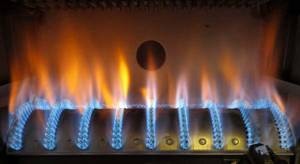
To make the stove a friend
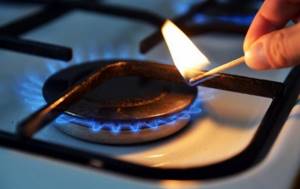
The specialist added that after the service life of gas-using equipment declared by the manufacturer expires, it must be diagnosed or replaced once a year. This also applies to equipment that has not been used since purchase.
For safety, you can install a special measuring device. Gas workers remind you that it is better to buy warning equipment in stores, and not from hand. Not so long ago, scammers were operating in Grodno, coming to the houses of city residents and offering to buy measuring instruments at an inflated price, posing as employees of the Grodnogaz production company. Denis Timoshko reminds: the company’s specialists have certificates and uniforms.
Current and current news from Grodno and the region in our Telegram channel. Subscribe via the link!
Reading time: 2 min
Although infrequently, news about exploding boilers still appears in emergency reports from time to time. And what’s most interesting is that the reason is not always a faulty stove or an unextinguished cigarette.
Possible causes of the accident
The occurrence of an emergency situation is associated with a number of factors. Accidents in boiler rooms occur primarily due to wear and tear of equipment and communication systems. According to statistics, the average wear and tear of communications in heat supply is 65%. An accident in a boiler room also results from the following reasons:
- fuel
_ The use of a gas mixture makes the boiler a “time bomb” and violation of proper operation modes can provoke an explosion. The cause of gas boiler explosions is oversaturation of the combustible mixture, which occurs when unburned fuel accumulates. Another reason for a fuel explosion is a malfunction of the burners; - decrease in water level
. Maintaining the required water level is the key to normal boiler operation. Prolonged operation of boiler equipment with insufficient water level can lead to heating of steel pipes and their melting; - violation of water treatment
. Accidents in boiler rooms involving industrial boilers occur due to insufficient water softening or water contamination. Water treatment is a mandatory procedure to reduce the amount of scale that forms and eliminate excess oxygen, which causes pitting oxygen corrosion. The cause of the accident due to a violation of water treatment is characterized by the appearance of through rust on a small area of equipment, leading to disruption of operation, which can cause an accident; - violation of the rules for heating the boiler
. When starting or stopping a boiler room, the equipment experiences increased loads, which requires strict adherence to operating rules. Compliance with the heating regulations and following the stages of the necessary start-up operations will guarantee a long service life of the boiler and prevent an accident.
Additional causes of accidents in boiler rooms include mechanical damage to pipes, improper storage of the boiler during idle mode, and errors in the installation of boiler equipment.
To avoid such problems, it is necessary to carry out timely certification of gas equipment. About the procedure and list of documents.
Boiler explosion. Causes of the explosion. Who installed the boiler?
“My home is my fortress” - the expression has become popular. This is exactly how we imagine our home; we are sure that while we are in it, we are completely protected from any external troubles, and especially domestic troubles. But what about internal dangers? We will talk about the danger that can lead not only to the destruction of your “fortress”, but also to injury or even death. This is an explosion of a solid fuel boiler. Most often, it is solid fuel boilers that explode. Gas boilers are less prone to such force majeure. So why do we see news about heating boiler explosions in media reports every winter? And 2019 was no exception. Why does a seemingly small and safe heating device cause the destruction of a house or the death of a person? Let's look at the possible reasons for such an incident.
The reasons for the explosion of a solid fuel heating boiler can be different: incorrect selection of equipment, incorrect installation (boiler piping), neglect of the rules for operating heating boilers, as well as the desire to save on simple safety systems. It is not enough to just BUY a solid fuel boiler, and just INSTALL a heating boiler!
What does “wrong selection of heating boiler” mean? It's simple. Recently, more and more often, when buying a wood-burning boiler, the client prefers to consider models with a deep firebox, which provide for heating a house with an area of 150 and above. But the larger the volume of the furnace in the boiler, the more the buyer likes this boiler. There is a nuance here, for an area of 50 sq.m. the boiler cannot and should not have such power. Excessive reserve power of the boiler is more of a harm than a benefit (this applies to heating systems that are installed without heat accumulators). Otherwise, when adding a larger volume of firewood, you cannot avoid overheating and “boiling” of the boiler - a so-called emergency situation. And this, in turn, leads to an increase in pressure in the boiler. Increased pressure in the boiler is not yet an explosion, but may precede it. You are one step closer to irreparable consequences.
The next step may be incorrect installation of the solid fuel boiler. In our country there are no strict rules regarding specialists installing household heating appliances in private homes. So they are installing wood-burning boilers for Uncle Vanya, Petya, etc. all over the country. Why are they trusted with such important work? The client does not always want to save money (not without this, of course), but we analyzed objects with solid fuel boilers and realized that the owners of private houses at the time of installation of the boilers did not have information about the installation rules and the specialists who wire the boilers. For owners of wood-burning boilers, it’s enough to hear the phrase “... yes, I’m boiling so much.” ..." And trust in such an installer is already high! Good modern solid fuel boilers are boilers with automatic control of the air supply to the combustion chamber and with sensors for controlling heating circuits. Very often the market of recommendations worked, like: - d. Vanya “cooked” my heating 10 years ago and everything still works. D. Vanya advised to take a Cooper or Mozyrselmash boiler….
It’s good that it works, it’s good that you advised... but over the past 10 years the fundamental approach to the home heating system has changed, and even more so to solid fuel heating boilers. The modern system and boilers have become more energy-dependent, but at the same time economical. Installation, management and operation of which require certain knowledge, skills and abilities. And also constantly being “in the know.” After installation, you must be told how to use the system with a heating boiler. And not just quickly explain where to put a match, but how to light a boiler, how to check for draft in the chimney, how to turn on pumps, what sensors to monitor and what taps should never be closed.
EXAMPLES OF INSTALLING SOLID FUEL BOILERS can be found HERE.
If you have chosen the right boiler and installed it correctly, then this is only half the success. According to statistics, the percentage of errors in operation is significantly higher than the number of errors during the installation of a solid fuel boiler. So, what should the owner of a solid fuel boiler pay attention to?
- Check the condition of the chimney. Is there soot, ice, or condensation there?
- Is there a flow of air into the furnace room, is the ventilation shaft clogged?
- Check the presence of coolant in the system and whether its quantity is sufficient. Open and closed systems have their own indicators.
- Check whether the valves on the boiler supply and return are open. And also whether the shut-off valves for the heating system of the house are open.
- In severe frosts, make sure that the heating line is not frozen. This often happens with periodic heating, for example in a country house or in production. It is also relevant for open systems with an expansion tank in the attic.
- Check if there is electricity in the network (for systems with a circulation pump - closed home heating systems).
Uncleaned boiler ash pan
Soot deposits in the ash pan can also cause a soot explosion. Therefore, this place in the boiler must be constantly monitored and soot removed in a timely manner. It is necessary to take into account the fact that the amount of soot in the ash pan (as in the chimney) depends on the quality of the fuel burned. Wet and resinous firewood will produce more soot than dry and clean firewood. Burning any kind of plastic in a firebox also leads to increased soot formation.
You should not clean the ash pan when the stove has not cooled down, because hot soot is a fire hazard. For the same reasons, you do not need to rake it out with your hands, but use a special shovel for this.
Types of gas boilers for heating a private home
One of the decisions when buying a boiler involves choosing the type of burner, so there are two options:
- Gas boilers for a private home with an open burner involve combustion of air that comes from the room. In this option, effective supply ventilation is of great importance. The exhaust of burnt air is carried out due to natural draft, so a chimney with a height of at least 4 m must be built.
- You can buy a boiler with a closed burner. In it, air is taken in and waste products are removed thanks to a fan. Such models are the most common because they do not require a high chimney and can function in any room.
Single-circuit gas boiler for heating a private house
Such models are designed to heat water only for heating, if you do not use additional equipment (boiler). Here the heat exchanger is a flow-through coil or “water jacket”, which is made of cast iron or steel. The volume of the indirect boiler should be taken into account, so its standard size is 100-120 liters. All complete parts for organizing the heating system will have to be purchased separately. It is better to install the boiler with the boiler in a separate room, since the decoupling system will look ugly.
When figuring out which gas boiler to choose, let’s look at the main advantages of single-circuit models:
- lower cost;
- high power and efficiency;
- less gas consumption.
Double-circuit gas boiler for heating a private house
Such models provide special devices designed for organizing hot water supply. In them, the heat exchanger is surrounded around the perimeter by a coil connected to the hot water supply or built into the boiler body. To be able to take a hot bath, heating gas boilers for a private home must have a power of at least 18 kW, and a shower - 10 kW. It is worth pointing out that in such devices there is unstable water pressure and coolant temperature. They have a number of advantages:
- small sizes;
- can be placed in a utility room;
- ease of operation.
Protecting solid fuel boilers from overheating using a heating radiator
A type 22 steel panel radiator with dimensions of 500x600 mm is used as a cooling radiator.

I decided to conduct a test: to check how long it would take for the boiler to boil if the circulation pump was turned off. We have a Stropuva boiler, and it burns for about a day.
Why is it necessary to perform pressure testing of heating after installation?
Therefore, our test will take place in two stages:
- Day 1. We melt the boiler, wait for it to reach a temperature of 60 degrees and turn off the circulation pump. We note the time during which the coolant in the boiler heats up to 100 degrees.
- Day 2. Remove the radiator from the piping circuit, heat the boiler and turn off the circulation pump. We note the time during which the coolant in the boiler heats up to 100 degrees.
About the heating system in this house
This house does not have a boiler room. The customer decided to place the boiler in the kitchen. I tried to dissuade him several times, but, as they say, “the master is the master.” I think after a while he will change his mind.
Get a heating system project for 100 rubles. per m²
The customer chose the wood-burning version of the Stropuva boiler, with a power of 15 kW. Behind the boiler there is a cooling radiator and a boiler piping made of copper.
A three-way thermostatic valve is installed in the piping, protecting the boiler return from cooling. The boiler piping consists of three circuits. The first circuit serves radiators. Manifold piping for radiators is implemented here. The collector group is located behind the wall, in the bathroom.
Gas double-circuit wall-mounted boiler - which is better?
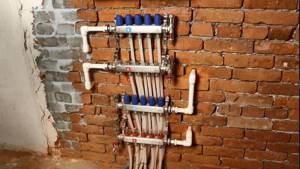
The second circuit is warm floors. The pumping and mixing unit is located behind the boiler, below the cooling radiator. The collector group for heated floors is also located in the bathroom. The third circuit is loading the indirect heating boiler.
It hasn't been installed yet. But there are special taps for this in the boiler piping. We placed collector groups in the bathroom. Warm floors cover the kitchen, bathroom, corridor and hallway. Radiators are installed in the bedrooms and living room.
Day 1. Testing a boiler with a radiator
The boiler heated up to 60 degrees, I turned off the circulation pump and waited for the temperature in the boiler to rise to 100 degrees. Within half an hour, the temperature on the boiler rose to 95 degrees and stopped.
3 hours have passed since the pump was turned off, and the temperature on the boiler has not risen above 95 degrees. I didn’t wait any longer and started the circulation pump in normal mode.
Day 2. Testing a boiler without a radiator
The boiler has heated up to 60 degrees, I turn off the circulation pump and wait for the temperature in the boiler to rise to 100 degrees. Without a radiator, the temperature in the boiler rose to 100 degrees in a little more than 30 minutes. Turned on the circulation pump.
It turns out that a radiator connected to the boiler by gravity protects against boiling. Our experiment can be seen in the video.
Why can a gas tank theoretically explode?
Let's figure out what pressure in the container we are talking about. The operating indicator for a gas tank is 5-6 atm. For comparison: the pressure in a conventional gas lighter is 3-4 atm, in a cylinder with natural gas - 200-220 atm.
The lighter and the gas holder have a similar operating principle, only the fuel volumes are different: 5 ml and 8,500 l (for a 10 m3 capacity). The liquid gas evaporates and forms a vapor cap. It is the vapor phase of propane-butane that is supplied through the gas pipeline to the boiler or stove.
The container is over 85% filled
The liquid phase has a large coefficient of volumetric expansion: 0.003 for propane and 0.002 for butane when the gas temperature increases by 1°C. Let’s take a 2700 liter SpetsGas gas holder:
- Refueling at 85% - 2295 liters (1836 liters of propane and 459 liters of butane). Expansion of propane at +1°C adds 5.5 l. Expansion of butane - 0.9 l.
- 100% filling - 2700 l (2160 l propane and 540 l butane). Expansion of propane at +1°C adds 6.5 liters. Butane expansion - 1 l. Keep in mind that the container is already filled to capacity and there is nowhere to put the excess pressure.
According to the rules of the UN Economic Commission for Europe, manufacturers have excluded this scenario: gas tanks are equipped with liquid phase alarm tubes and float shut-off valves that prevent the tank from overfilling.
The air in the system has formed an explosive mixture (1.5-9.5% by volume)
Situation 1. The owners of the gas tank have emptied the tank by more than 10-15%, a vacuum has formed in the tank, which sucks air from the boiler.
Solution: fill the tank on time (we install telemetry that monitors the fuel level and displays the data in the application).
Situation 2. Refuelers without special equipment violated the tightness of the tank filling process.
Solution: contact licensed gas suppliers. Termo Life specialists comply with safety standards (the complete pipeline is sealed, the gas carrier is secured, etc.) and use high-quality equipment (the Corken Z 2000 pump operates under conditions of vapor formation that occurs during suction).
If you want to know all about using a gas tank safely, talk to an engineer.
